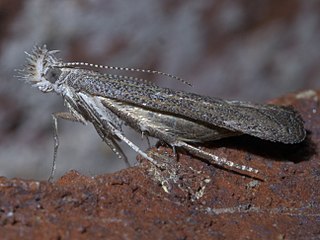
Isophrictis is a genus of moths in the family Gelechiidae.

Isophrictis striatella is a moth of the family Gelechiidae. It is found in most of Europe, as well as Turkey and North America.

Isophrictis anthemidella is a moth of the family Gelechiidae. It is found from most of Europe to the Caucasus and Central Asia.
Isophrictis anteliella is a moth of the family Gelechiidae. It was described by August Busck in 1903. It is found in North America, where it has been recorded from Illinois, Ohio, New Jersey and Texas.
Isophrictis cilialineella is a moth of the family Gelechiidae. It was described by Vactor Tousey Chambers in 1874. It is found in North America, where it has been recorded from Texas.
Isophrictis pallidella is a moth of the family Gelechiidae. It was described by Vactor Tousey Chambers in 1874. It is found in North America, where it has been recorded from Colorado and Texas.
Isophrictis trimaculella is a moth of the family Gelechiidae. It was described by Vactor Tousey Chambers in 1874. It is found in North America, where it has been recorded from Kentucky and Texas.

Isophrictis similiella is a moth of the family Gelechiidae. It was described by Vactor Tousey Chambers in 1872. It is found in North America, where it has been recorded from Kentucky, Arkansas, Illinois, Indiana, Maine, Manitoba, Massachusetts, Oklahoma, Pennsylvania, Saskatchewan and Texas.
Isophrictis tophella is a moth of the family Gelechiidae. It was described by Walsingham in 1888. It is found in North America, where it has been recorded from California, Arizona and New Mexico.
Isophrictis actiella is a moth of the family Gelechiidae, described by William Barnes and August Busck in 1920. It is found in North America, where it has been recorded from California.
Isophrictis actinopa is a moth of the family Gelechiidae, described by Edward Meyrick in 1929. It is found in North America, where it has been recorded from Texas.
Isophrictis cerdanica is a moth of the family Gelechiidae. It was described by Jacques Nel in 1995. It is found in Spain.
Isophrictis corsicella is a moth of the family Gelechiidae. It was described by Hans Georg Amsel in 1936. It is found in Spain and on Corsica and Sardinia.
Isophrictis impugnata is a moth of the family Gelechiidae. It was described by László Anthony Gozmány in 1957. It is found in Spain.
Isophrictis meridionella is a moth of the family Gelechiidae. It was described by Gottlieb August Wilhelm Herrich-Schäffer in 1854. It is found in Spain, France and on Sardinia.
Isophrictis microlina is a moth of the family Gelechiidae. It was described by Edward Meyrick in 1935. It is found in Spain.
Isophrictis occidentalis is a moth of the family Gelechiidae. It was described by Annette Frances Braun in 1925. It is found in North America, where it has been recorded from Utah.
Isophrictis robinella is a moth of the family Gelechiidae. It was described by Pierre Chrétien in 1907. It is found in southern France.
Isophrictis oudianella is a moth of the family Gelechiidae. It was described by Daniel Lucas in 1942. It is found in Tunisia.


